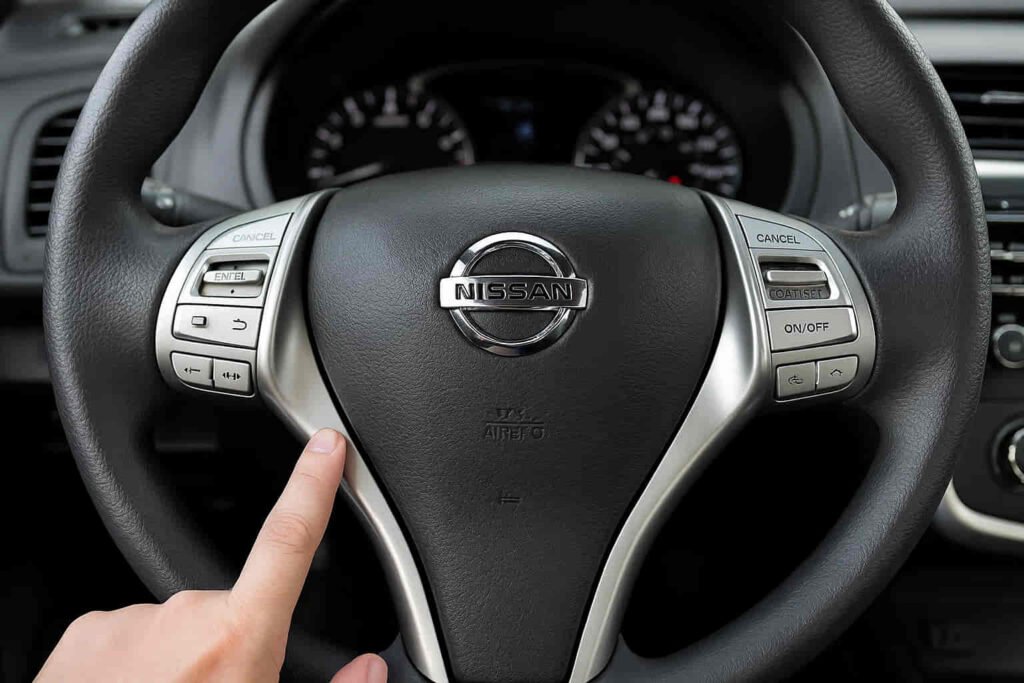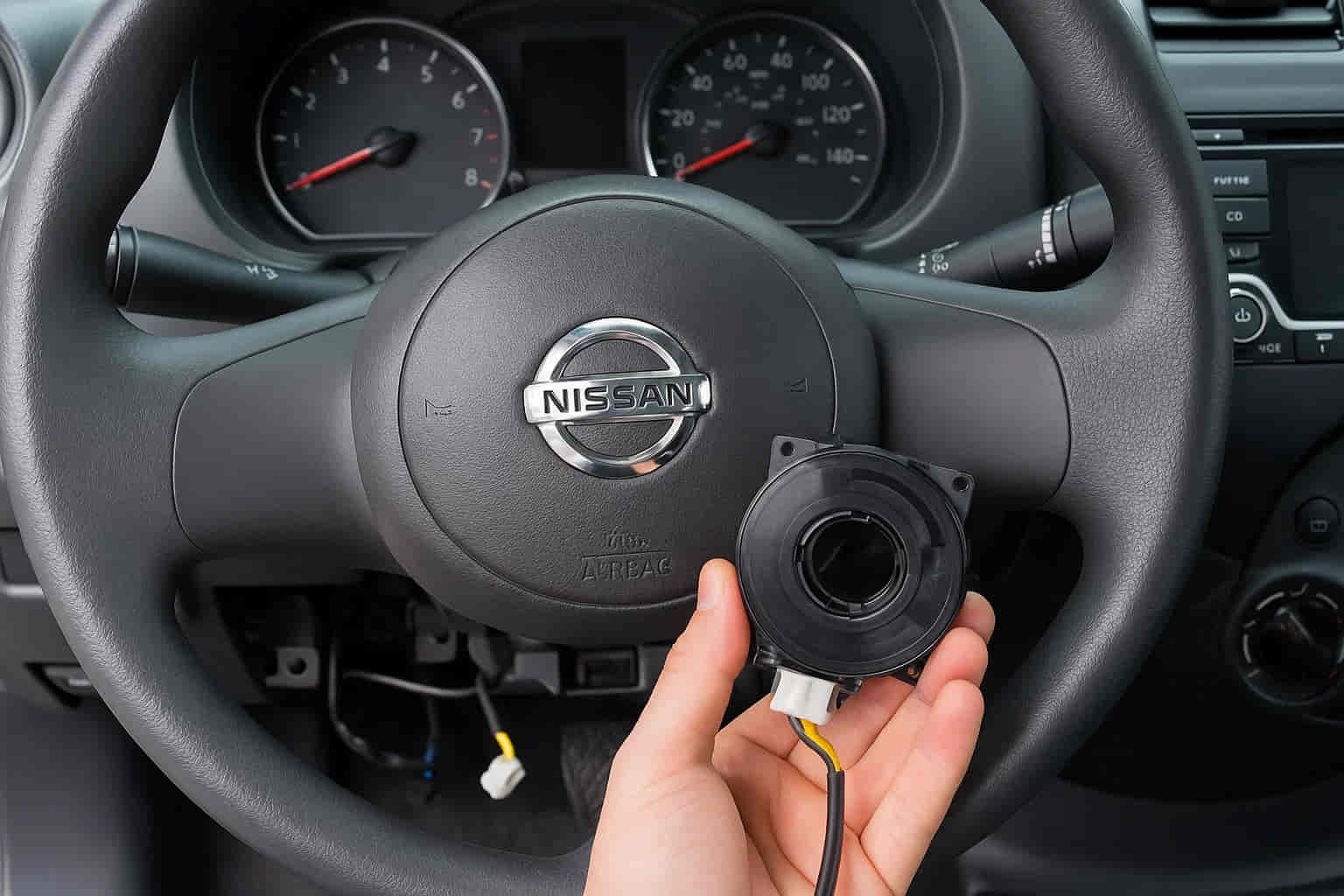When you finish a wheel alignment on your Nissan and suddenly notice the ABS light flashing or the steering wheel feels slightly off-center, the culprit is often the steering angle sensor. This small but essential component tells your car’s computer how far the wheels are turned, keeping systems like ABS, traction control, and stability assistance working correctly. If the data it sends is inaccurate, even by a small margin, your Nissan may pull to one side, warning lights may appear on the dashboard, and safety features can be compromised.
That is why performing a Nissan steering angle sensor reset is not just a technical task but a necessary step to restore driving stability. Many owners assume the issue requires expensive dealer service, but in reality, you can recalibrate the sensor at home with the right approach. In this complete DIY guide, we will walk through how the reset works, what tools are needed, and why it solves common alignment and ABS issues. Whether you are trying to save money, avoid repeated trips to the mechanic, or simply want your Nissan to drive the way it should, this tutorial will give you the confidence to handle the reset safely.
What Is a Steering Angle Sensor and Why It Matters
A steering angle sensor, often referred to as SAS, is one of the most important electronic components inside your Nissan’s steering column. Its job is simple in theory but critical in practice: it measures the position and rate of rotation of the steering wheel, then communicates that data directly to the ECU and the vehicle’s safety systems. Every time you turn the wheel, the SAS ensures that systems like ABS, electronic stability control, and traction control respond instantly and correctly.
When the steering angle sensor becomes misaligned or sends inaccurate data, the car’s onboard systems cannot make proper calculations. This can result in an off-center steering wheel after alignment, traction control not engaging at the right moment, or even the ABS warning light staying on. Many Nissan drivers first notice the issue after suspension work, wheel alignment, or battery replacement, because these are common situations where the sensor loses calibration.
This is exactly why a Nissan steering angle sensor reset matters. Without recalibration, your vehicle may feel unstable, especially during sharp turns or on wet roads, and the dashboard may continue to show warning lights. By restoring the sensor to its correct position, you bring the entire safety network of your Nissan back to full accuracy, ensuring both comfort and safety behind the wheel.
Symptoms That Your Nissan Needs a Steering Angle Sensor Reset
Drivers often realize something is wrong only after the warning lights appear or the steering no longer feels natural. In many cases, the first sign of trouble is an illuminated ABS or traction control light that refuses to turn off, even after restarting the engine. This happens because the steering angle sensor is out of sync with the vehicle’s actual wheel position, confusing the onboard computer and forcing it to trigger a safety warning.
Another common symptom is an off-center steering wheel, especially noticeable after a fresh wheel alignment. You may drive straight down the road, yet the wheel itself points slightly left or right. Not only is this frustrating, but it also indicates that the data being sent from the sensor is inaccurate, which can affect handling in emergency situations.
Some Nissan owners report a feeling of instability during turns, as if the vehicle hesitates to correct itself or pulls unexpectedly to one side. In these cases, the sensor may not be communicating quickly enough with the stability control system, reducing the effectiveness of traction management on slippery or uneven roads.
If you experience any of these issues—warning lights that won’t disappear, a steering wheel that won’t center, or unpredictable handling—it is a strong indication that your car requires a Nissan steering angle sensor reset. Identifying these symptoms early prevents further strain on your braking and stability systems, ensuring your Nissan continues to perform as safely and smoothly as it was designed to.
Tools You’ll Need for a DIY Nissan Steering Angle Sensor Reset
Before attempting a Nissan steering angle sensor reset, having the right tools makes the difference between a quick, successful calibration and hours of frustration. The most essential piece of equipment is an OBD2 scanner with steering angle sensor functionality. Not every scanner can access the ABS or stability control module, so it’s important to choose one compatible with Nissan vehicles—brands like Autel, Launch, and BlueDriver are reliable options for this task.
Equally important is ensuring your Nissan is parked on a perfectly flat surface, with the wheels pointed straight ahead. A misaligned starting position can cause the reset to fail or even create new errors. Some drivers use chalk marks on the tires or the garage floor to confirm the wheel position remains perfectly centered throughout the process.
Since electronic calibration requires uninterrupted power, a fully charged battery is another critical requirement. A weak battery can cut the reset short and leave the system in a faulty state, forcing you to start over. For those who like to prepare thoroughly, having a basic set of mechanic’s tools on hand is useful for checking the steering column or related components if the reset doesn’t work on the first attempt.
With these essentials—an OBD2 scanner, a level surface, a stable power supply, and a bit of patience—you can handle the reset process at home with confidence. Skipping any of these tools increases the risk of incomplete calibration, which is why proper preparation is the foundation of every successful DIY reset.
How to Perform Nissan Steering Angle Sensor Reset (Step-by-Step DIY Guide)

Resetting the steering angle sensor on a Nissan can be done in more than one way, depending on the model year and the tools you have available. The good news is that both methods follow the same principle: bring the sensor back in line with the actual steering position so that the ABS and stability systems can interpret wheel movement correctly.
For certain Nissan models, a manual reset is possible without any special equipment. To attempt this method, begin by turning the ignition to the ON position without starting the engine. Slowly rotate the steering wheel all the way to the left, then all the way to the right, and finally bring it back to the exact center. Switch the ignition OFF, wait a few seconds, and then restart the vehicle. In some cases, this sequence allows the ECU to relearn the steering angle and clear the warning lights. While not always effective, it is worth trying before moving to a more advanced solution.
The more reliable method is using an OBD2 scanner that supports SAS calibration. Connect the scanner to the diagnostic port under the dashboard, then select the ABS or steering module from the menu. Within the tool’s functions, choose “Steering Angle Sensor Reset” or “Calibration” and follow the prompts on screen. Most scanners will ask you to keep the wheels perfectly straight while the calibration is performed. After a few seconds, the process usually completes, and the dashboard warning lights should turn off.
Regardless of which method you use, it is critical to ensure the steering wheel is perfectly centered and the car is on a flat surface. Even a small error in positioning can cause the reset to fail. Once complete, take your Nissan for a short test drive, paying attention to whether the ABS and traction control lights remain off and the steering feels balanced. If the symptoms return, repeating the process with a scanner is often the most reliable fix.
Cost of Nissan Steering Angle Sensor Reset: DIY vs. Mechanic
The cost of a Nissan steering angle sensor reset can vary significantly depending on where and how you choose to perform it. For many drivers, the most affordable option is to do it yourself with an OBD2 scanner. A decent scanner with SAS calibration support can be purchased for around $80 to $150, and once you own the tool, you can use it as often as needed—not only for resets but also for reading and clearing other diagnostic codes. Over time, this investment pays for itself.
If you decide to visit an independent mechanic, the reset alone usually costs between $80 and $120, depending on the shop’s hourly labor rate. This can be a good option if you are not comfortable with electronics or if your Nissan has additional issues that require professional attention. Many garages bundle this service with wheel alignment, since recalibrating the steering angle sensor is often necessary immediately afterward.
At the dealership, costs are typically higher. A reset at a Nissan dealer can run from $120 to $180, and if the sensor itself needs replacement, the bill may climb to $300 or more. While dealers have the most specialized equipment and trained technicians, the premium pricing can be difficult to justify for something as straightforward as a calibration.
Ultimately, choosing between DIY and professional service comes down to your comfort level. If you prefer convenience and peace of mind, a mechanic or dealer reset is worth the extra money. But for drivers who enjoy hands-on maintenance, a DIY reset with the right scanner is the most cost-effective solution.
Common Mistakes and Troubleshooting Tips
Performing a Nissan steering angle sensor reset at home is straightforward once you know the process, but many DIY attempts fail because of small oversights. One of the most common mistakes is starting the reset with the steering wheel slightly off-center. Even a few degrees of misalignment can cause the ECU to store incorrect data, leaving the ABS or traction control light still illuminated. Always ensure the wheel is perfectly straight before initiating calibration.
Another frequent issue comes from weak or unstable battery voltage. Since the reset relies on continuous communication between the ECU and the sensor, a drop in power can interrupt the process and create new error codes. Checking that your Nissan’s battery is fully charged before starting is a simple step that prevents wasted effort.
Using the wrong OBD2 scanner is also a source of frustration. Not all budget tools support SAS functions, and some generic scanners can only read engine codes, not ABS or steering modules. If your tool does not show “Steering Angle Sensor Reset” or “Calibration” as an option, it likely isn’t compatible. Investing in a scanner known to work with Nissan models is essential.
Finally, don’t panic if the first reset attempt doesn’t clear the warning lights. In many cases, repeating the process a second or third time resolves the issue. If problems persist, it may indicate a deeper fault such as a damaged sensor or wiring issue, in which case professional inspection is the safest path forward.
When to Seek Professional Help
While a Nissan steering angle sensor reset can often be handled at home, there are situations where professional assistance becomes the best option. If you have repeated the calibration process multiple times with a reliable OBD2 scanner and the ABS or traction control lights still refuse to clear, it usually means the issue goes beyond a simple reset. In such cases, the sensor itself may be damaged, or the wiring inside the steering column could be faulty.
Another clear sign that you need professional help is when the reset temporarily works but the warning lights reappear after a short drive. This cycle of success and failure points to an underlying mechanical or electrical problem that requires diagnostic equipment beyond what most DIYers own. Mechanics and dealers have access to advanced factory-level scanners that can run deeper tests and confirm whether replacement is necessary.
If your Nissan exhibits unusual symptoms—such as sudden pulling to one side, steering resistance during turns, or multiple dashboard warnings activating at once—this is also a red flag. Continuing to drive with these issues not only risks safety but can also put additional strain on other components, leading to more expensive repairs later.
In these scenarios, visiting a certified mechanic or Nissan dealer ensures the problem is properly identified and corrected. While it may cost more than a DIY attempt, professional calibration and inspection provide peace of mind that your ABS, traction control, and stability systems are functioning as intended.
Conclusion
The steering angle sensor may be hidden inside your Nissan’s steering column, but its role in keeping your car safe and stable is undeniable. When this sensor is out of calibration, the ABS, traction control, and stability systems cannot respond accurately, which is why even a simple wheel alignment can trigger warning lights and handling issues. Performing a Nissan steering angle sensor reset restores that balance, ensuring your vehicle drives the way it was engineered to.
The good news is that this reset does not always require a costly trip to the dealer. With a compatible OBD2 scanner and careful preparation, many owners successfully complete the calibration at home, saving both time and money. The process may take only a few minutes but can resolve frustrating problems such as an off-center wheel, persistent ABS lights, or unpredictable traction control behavior.
Of course, not every situation can be solved with a DIY approach. If resets fail repeatedly or warning lights return quickly, seeking professional help is the safest choice. Whether you choose to handle the reset yourself or rely on a certified mechanic, understanding how the process works gives you more control over your Nissan’s maintenance. By addressing the issue promptly, you protect both your safety and your car’s long-term performance.

